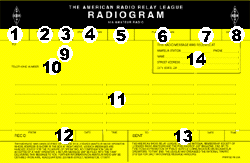














 Hancock Auxcomm Team was established in 2018 and is an ARRL Affiliated club.
Hancock Auxcomm Team was established in 2018 and is an ARRL Affiliated club.
|
ARRL RADIOGRAMS
|
 The following are the fields that are completed when writing NTS Radiogram formatted messages.
The fields are read and written in the order shown in the graphic to the right. The items numbered 1 through 8 are considered the preamble of the message. All fields in the preamble are required except items 3 and 7.
Items 12 -14 are not send on the air. These fields are filled in by the station handling the traffic after the message is sent or received to help track the path of the message through the system.
The following are the fields that are completed when writing NTS Radiogram formatted messages.
The fields are read and written in the order shown in the graphic to the right. The items numbered 1 through 8 are considered the preamble of the message. All fields in the preamble are required except items 3 and 7.
Items 12 -14 are not send on the air. These fields are filled in by the station handling the traffic after the message is sent or received to help track the path of the message through the system.
- Item number 1 is the message number. This is a sequential number that is assigned by the originating station.
- Item 2 is the precendence. The possible options for this field are Emergency, Priority, Welfare or Routine.
- Item 3 is Handling instructions. Possible options for this field are HXA, HXB, HXC, HXD, HXE, HXF or HXG. This is not a required field and may be omitted. If omitted, HXG is assumed.
- Item 4 is the call sign of the originating station.
- Item 5 is the message count. This is a count of the number of words contained in the message (Item 11). The letters "ARL" appear before the count if the message contains an ARRL numbered radiogram message in the text.
- Item 6 is the city and state of origin. This is not necesarily the same city as the station of origin. This reflects the place of origin of the third party for whom the traffic is being sent.
- Item 7 is the time the message was originated. This is not a required field and may be omitted.
- Item 8 is the date of origin. This is normally written as the first 3 letters of the month followed by the day of the month. (i.e. APR 30)
- Item 9 is the full name, callsign (if appropriate), and address of the person that is to receive the message.
- Item 10 is the phone number, if known, including the zip code.
- Item 11 is the actual text of the message. This is normally limited to 25 words or less. ARRL numbered radiograms may be used to keep the word count to a minimum.
- The salutation (i.e. love... miss you... sincerely...etc.) are counted as part of the message text. The signature of the third party sending the message follows, but is not included in the word count. (i.e. Uncle Bob... Your sister Theresa... Mom and Dad... Etc.)
- Item 12 is used to record the station from which the message was received. Also recorded here is the date and time received. This should reflect UTC time and date to avoid confusion.
- Item 13 is used to record the station to which the message was sent. Also recorded here is the date and time sent. This should reflect UTC time and date to avoid confusion.
- Finally, Item 14 is used to record your contact information. This is used when sending the message via the post office or when multiple operators are handling messages in one location. This helps with record keeping should there be any questions later about the message or who has handled it.
An example of a properly completed NTS radiogram and the correct way to send the the message using various modes of operation can be found here.
NTS |
Radiograms |
Precedence |
Handling Instructions
Word Count |
Numbered Messages |
Sending |
Delivering
|
Copyright © Hancock Auxcomm Team (WV8HAT) All Rights Reserved.
|

















 Hancock Auxcomm Team was established in 2018 and is an ARRL Affiliated club.
Hancock Auxcomm Team was established in 2018 and is an ARRL Affiliated club.